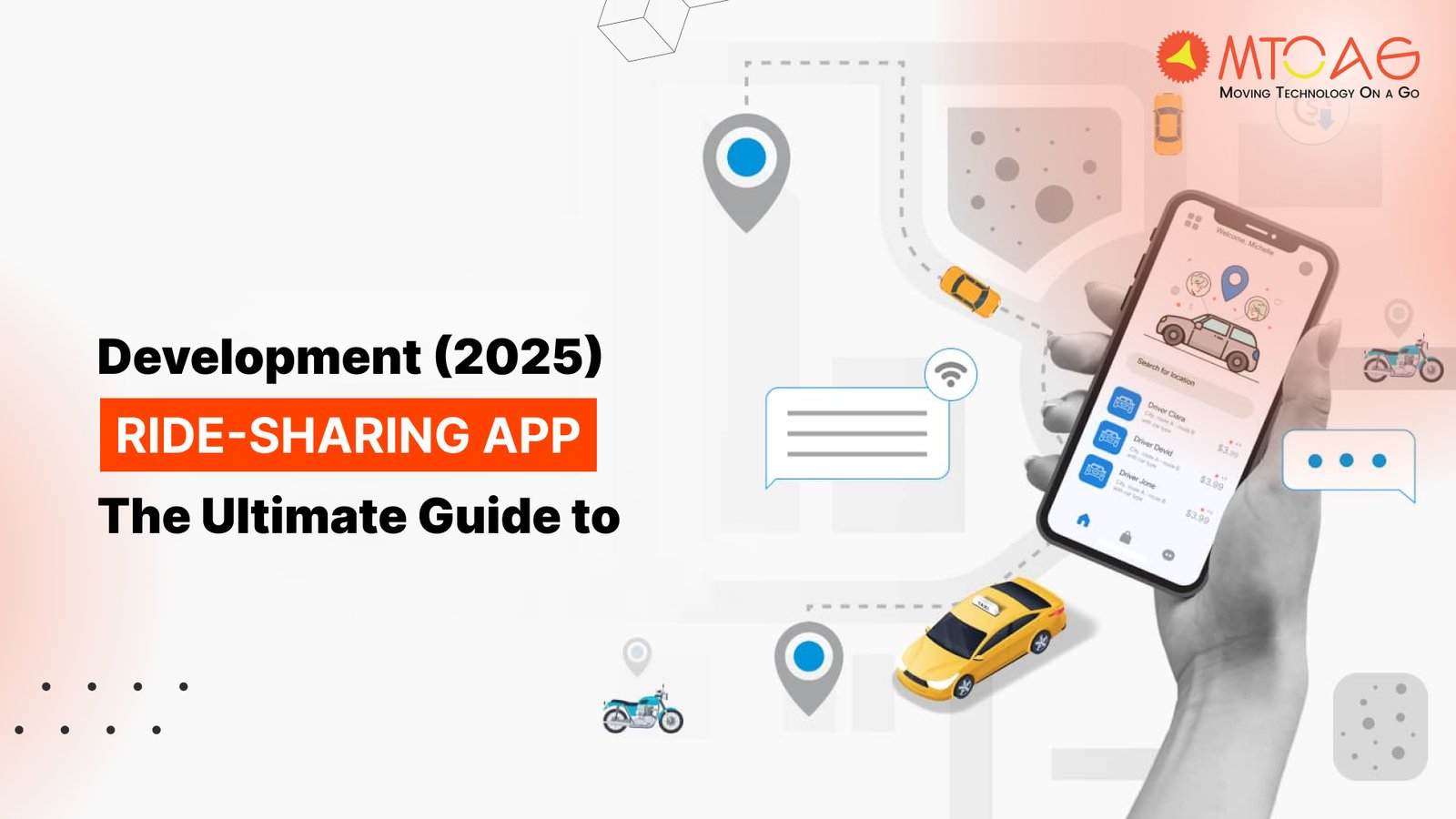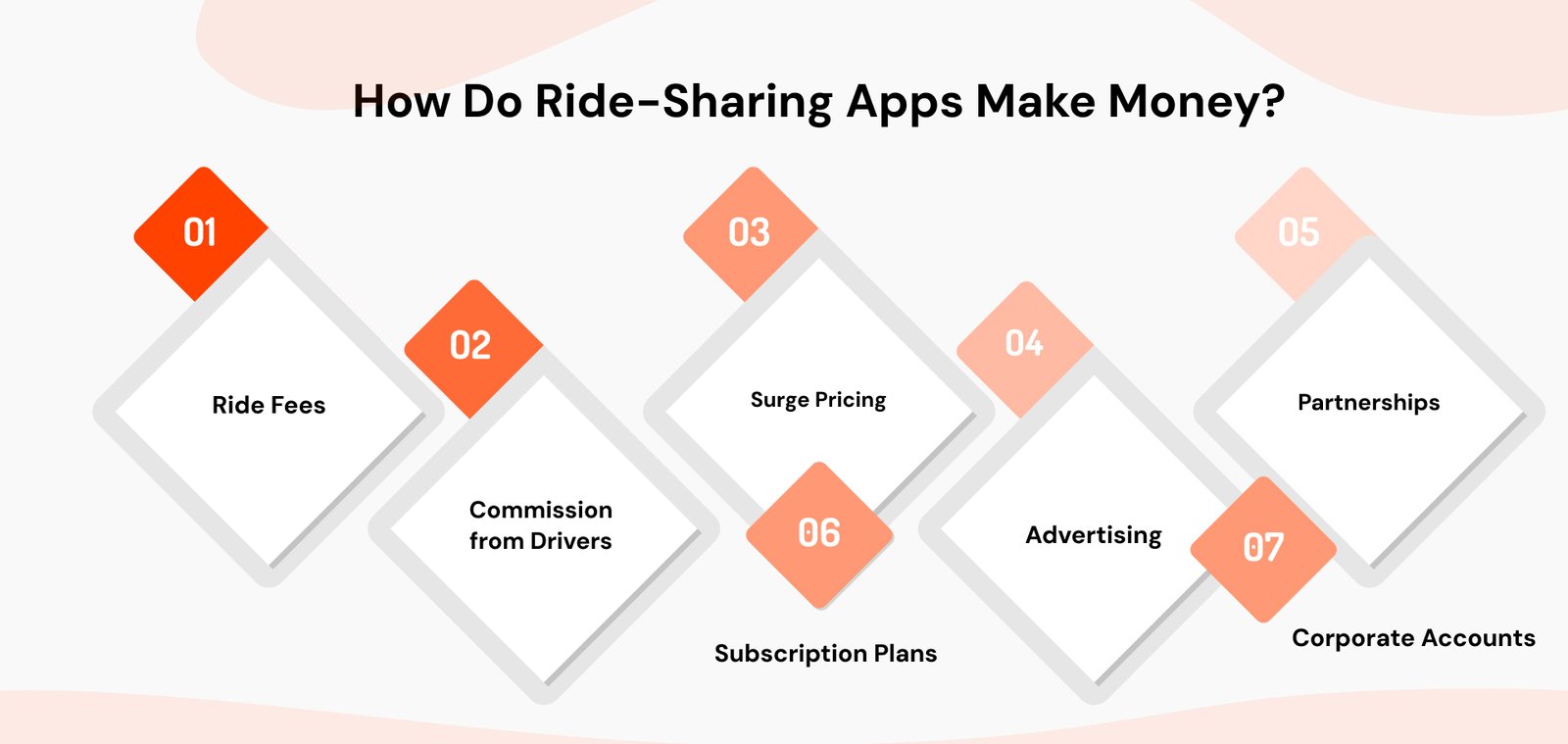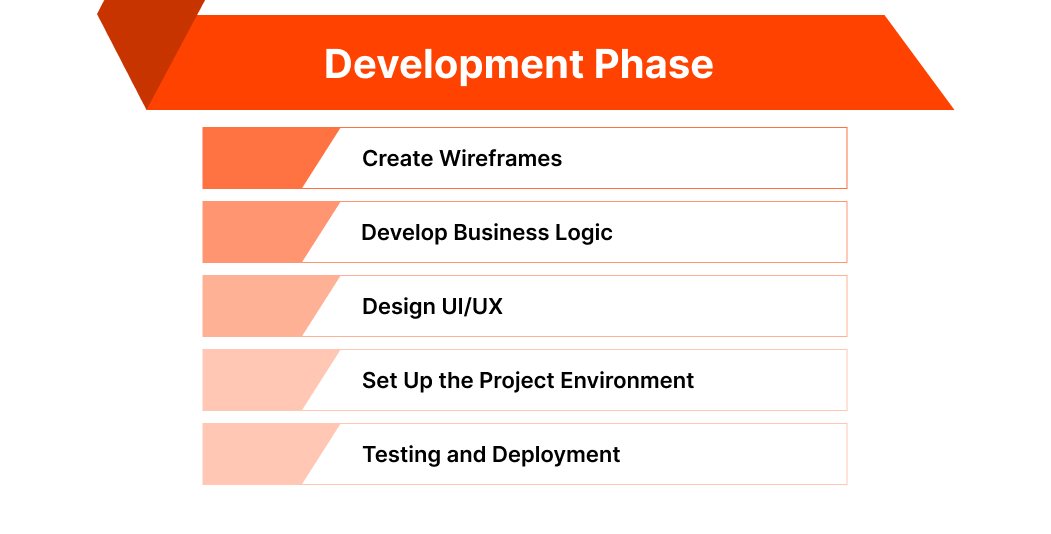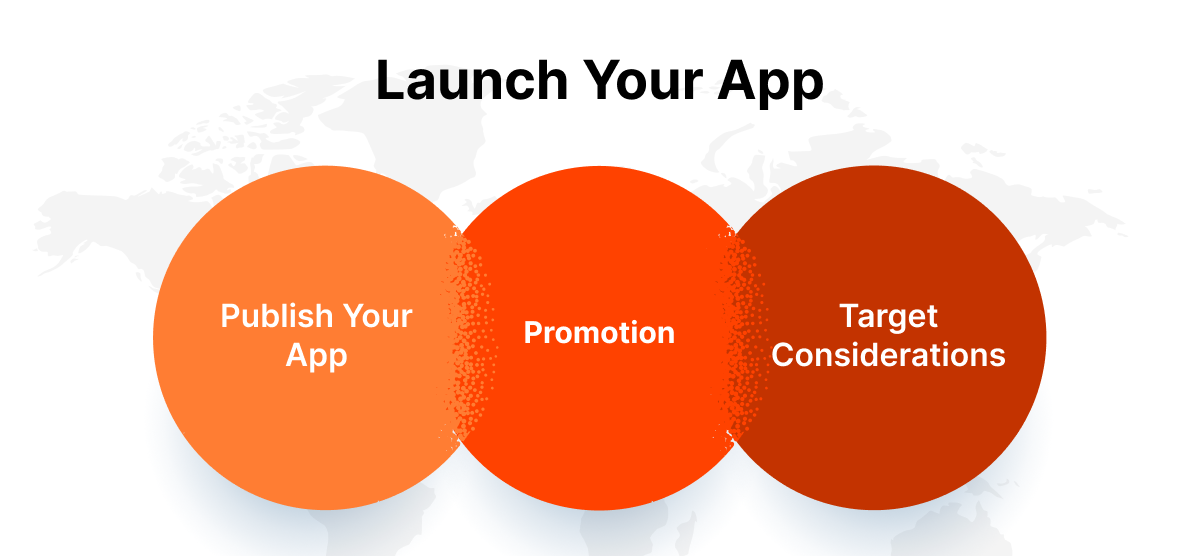2500+
Successful Projects

In 2010, when Uber was first launched in San Francisco, who would have imagined that it would become the largest ride-sharing service it is today? Uber's success has led to increasing demand for ride-sharing app development. We have seen many Uber competitors, like Lyft, Ola, and Bolt; however, Uber’s global reach and unique business model are what make it stand out from the rest. Despite Uber’s dominance in the ride-sharing industry, there is still ample opportunity for new taxi app businesses to thrive by offering unique features, better customer service, or targeting specific markets.
Table of Contents
As an entrepreneur, what more do you know about building a rideshare app like Uber? In fact, the global taxi market was worth $147.28 billion in 2023 and is expected to increase to $357.9 billion by 2032 at a CAGR of 4.9%.
You can also be a part of this growing ecosystem of ride-sharing services; the only thing you need to understand is how to make a ride-sharing app. So, to help you out with your doubts and queries, we have created this detailed and definite guide to ride-sharing app development and how you can hire ride-share app developers to tap into this high-demanding business opportunity.

A ride-sharing app is a specialized mobile app that allows people to book rides with drivers using their smartphones. Instead of hailing a taxi on the street or calling a cab company, you can use these apps to find a nearby driver to pick you up and take you to your destination.
When you open the app, it shows your location and the available drivers in your area. You enter your destination, and the app matches you with a driver. It also shows the estimated fare and how long it will take for the driver to arrive.
These apps usually let you pay using a credit card, debit card, or digital wallet through the app itself, which is comparatively more convenient than traditional taxi booking services.
Yes, investing in ride-sharing app development can be profitable, as seen from the success of Uber, Lyft, Ola, and DiDi. However, it depends on several factors. The demand for ride-sharing services is growing. More people are using apps like Uber and Lyft for their daily transportation needs. This means there is a market for new ride-sharing apps.

A well-developed ride-sharing app can attract many users if it offers good features and services. Features like easy booking, secure payments, and reliable drivers can make the app popular. If the app is user-friendly and meets the needs of passengers and drivers, it can succeed.
However, carpooling app development involves good upfront costs. You need to invest in technology, marketing, and customer support. Competition is also a challenge. Many big companies dominate the market, so your app needs to stand out.
Investing in ride-sharing app development can be profitable if you can overcome these challenges and provide a unique and useful service.
The popularity of ride-sharing apps like Uber and Lyft has opened doors for new players. They make it easy for people to book rides using their smartphones. But have you ever wondered - how these apps make money? They use different monetization models to make money, including
The primary source of income for ride-sharing businesses is charging passengers a fee for each ride. When you book a ride, the app calculates the fare/ride cost based on the distance, time, and sometimes surge pricing if it's a busy time. The app takes a percentage of this fare as its revenue, and the rest goes to the driver.
Ride-sharing apps also profit from driver commissions. When a driver completes a ride, the app commissions a small percentage of the fare. This helps the app earn money from each ride.
During busy times, like rush hour or special events, ride-sharing apps use surge pricing. This means the fare increases due to high demand. The extra money from surge pricing goes to the app, boosting their earnings during peak times.
Some ride-sharing apps offer subscription plans. These plans let passengers pay a monthly fee for benefits like discounted rides, priority booking, or free cancellations.

Ride-sharing apps can also make money from advertising. They can show ads within the app or partner with other companies to promote their products. This can include in-app advertisements, sponsored rides, or special promotions.
Many ride-sharing apps form partnerships with restaurants, hotels, and other businesses. These partnerships can generate additional revenue through promotions and special deals for passengers.
Some ride-sharing apps offer corporate accounts to businesses. Companies can use these accounts for their employees’ travel needs, and the app charges the company based on the rides used.
Creating a ride-sharing app like Uber or Lyft might look challenging at first, but with the right steps, it can be done successfully. As experienced ride-share app developers, we understand the process well. Here is a simple, step-by-step guide to help you get started:
The pre-development phase is all about planning your ride-sharing app. This is where you outline your target market and potential customers. There are several important things to consider before you start developing your app. Here are the key steps:
#1. Research & Analysis
#2. Analyze Competitors
#3. Define Your Target Audience
#4. Define Key Features
After doing your research and analysis, you should have a good idea of what your target audience needs. Now, you can define the key features that your app should have. These features should be user-friendly and meet the demands of your market. Here are some examples of features to consider:
User | Driver | Admin |
Login & Signup | Login & Signup | Business Management |
Map navigation | Map navigation | Zone and fare |
Find driver | Find rider | Driver management |
Live chat and call | Automatic fare calculation | Transaction management |
Multiple payment options | Loyalty & gamification | Trip management |
Rider profile | Live chat and call | User management |
Review and rating system | Driver profile | Promotion management |
Trip History | Track rider location | 3rd party configurations |
Wallet | Commission charge setup | |
Loyalty Point |
#5. Choose Tech Stack
Choosing the right technology for your ride-sharing app is important. It determines how your app will work and perform. Here are some simple tips to help you decide on the tech stack for your ride-sharing app:
#1. Create Wireframes
Wireframes are like blueprints for your app. They help you visualize how the app will look and work. To create wireframes:

#2. Develop Business Logic
Business logic is the set of rules that control how your app functions. It includes:
#3. Design UI/UX
The User Interface (UI) and User Experience (UX) design make your app easy to use and pleasant to look at. Here’s how to work on UI/UX:
#4. Set Up the Project Environment
Set up the environment where your development team will work. This includes setting up the necessary software, tools, and frameworks for the development process.
#5. Testing and Deployment
After completing the development, it's crucial to test your app thoroughly. This ensures it works well across different devices and screen sizes and provides a good user experience.
Test the app to find any bugs or issues. Fix these to ensure the app runs smoothly. Make sure all features work as expected on various devices.
Here’s how you can test your app before its release:
Once testing is complete, it's time to move on to the post-development phase. This phase includes launching your app and activities that follow the launch. Here’s what you need to do:
#1. Launch Your App
A strategic launch plan is crucial for the success of your ride-sharing app. Here are the steps:

#2. Branding and Marketing
Building a strong brand identity is essential for your ride-sharing business. Here are the key steps:
#3. Continuous Improvement and Maintenance.
Now that your ride-sharing app has gained brand recognition and your target customers are joining every day, it's crucial to keep improving and maintaining the app. Here are some steps to ensure your app stays top-notch:
The cost to create a ride-sharing app can vary widely based on the features you want. Simple apps are cheaper and quicker to develop, while more complex apps with advanced features are more expensive and take longer to build. Planning your budget carefully and understanding the costs involved will help you create a successful app.
Here's a simple breakdown:
The cost of hiring developers is a big part of the budget. On average, ride-share app developers charge between $40 and $100 per hour, but the exact rate depends on their experience and location.
A simple ride-sharing app with basic features like user registration, ride booking, and payment integration can cost around $30,000 to $50,000. This covers about 3 to 6 months of development time.
If you want more advanced features like real-time GPS tracking, in-app messaging, and multi-language support, the cost can go up to $50,000 to $90,000. This usually takes 6 to 10 months to develop.
The cost of a highly complex app with features like AI-powered route optimization, advanced analytics, and integration with third-party services can range from $90,000 to $120,000. It can take 10 to 15 months to complete.
Besides developer fees, you will need to budget for design, testing, marketing, and maintenance. These costs can add up, so it's important to plan carefully.
Mtoag Technologies can significantly assist with ride-sharing app development by offering customized solutions tailored to your needs. Their experienced team of developers knows how to create effective ride-sharing apps from start to finish. They bring their expertise to guide you through the process, ensuring your app is functional and user-friendly.
Mtoag Technologies offers cost-effective services without compromising quality, ensuring the app fits your budget. They provide continuous support and maintenance, addressing any issues that arise and keeping the app running smoothly.
Additionally, they can incorporate innovative features such as real-time tracking, in-app payments, and driver ratings, which enhance the user experience. Their comprehensive approach, including custom development, expert guidance, budget-friendly solutions, and ongoing support, makes them a reliable partner in creating a successful ride-sharing app.
Ride-sharing apps have made getting around more accessible, affordable for everyone, and good for the environment. They help users save money on rides and help car owners save on fuel. Plus, these apps are top-rated, and many people use them every day.
Now that you know the process of making a ride-sharing app, you have a better idea of how to build one yourself. Apps like Uber, Lyft, and BlaBlaCar are the top names in the market; you can learn a lot from their successful business models.
Do you have an idea for creating a ride-sharing app? Our expert team of ride-share app developers and designers can help! With years of experience, we know how to take on ride-sharing app development projects. We are a leading software development company, and we have successfully completed over 2500+ projects.
The future of ride-sharing looks promising with advancements in technology. Autonomous vehicles, or self-driving cars, are likely to play a significant role. These vehicles could reduce costs and improve safety. Additionally, the integration of AI can enhance route optimization and customer experience. Ride-sharing services might also expand to offer more sustainable transportation options, such as electric vehicles.
To develop a carpooling app, start with market research to understand user needs and competitors. Define your app’s key features like user registration, ride matching, real-time tracking, and payment options. Choose the right technology stack, such as React Native for cross-platform compatibility and Node.js for backend development. Create wireframes to visualize the app's layout and user flow. Develop and test the app thoroughly to ensure it works well. Finally, launch the app and gather user feedback for continuous improvement.
Yes, ride-sharing apps use AI to improve their services. AI helps route optimization by analyzing traffic patterns and suggesting the fastest routes. It enhances customer service through chatbots that can handle queries and issues efficiently. AI also helps ensure safety by monitoring driver behavior and providing real-time alerts.
Building a ride-share app typically takes between 6 to 12 months, depending on the complexity and features of the app. The development process includes market research, planning, designing wireframes, coding front and backend components, and thorough testing.